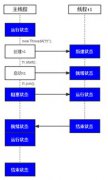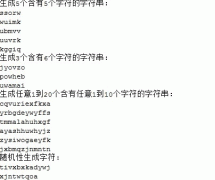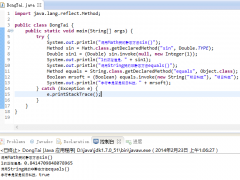Java2源码解读:java.util.ArrayList
ArrayList是List接口的一个可变长数组实现。实现了所有List接口的操作,并答应存储null值。除了没有进行同步,ArrayList基本等同于Vector。在Vector中几乎对所有的方法都进行了同步,但Arr
ArrayList是List接口的一个可变长数组实现。实现了所有List接口的操作,并答应存储null值。除了没有进行同步,ArrayList基本等同于Vector。在Vector中几乎对所有的方法都进行了同步,但ArrayList仅对writeObject和readObject进行了同步,其它比如add(Object)、remove(int)等都没有同步。
1.存储
ArrayList使用一个Object的数组存储元素。
private transient Object elementData[];
ArrayList实现了Java.io.Serializable接口,这儿的transient标示这个属性不需要自动序列化。下面会在writeObject()方法中具体讲解为什么要这样作。
2.add和remove
public boolean add(Object o) {
ensureCapacity(size + 1); // Increments modCount!!
elementData[size++] = o;
return true;
}
注重这儿的ensureCapacity()方法,它的作用是保证elementData数组的长度可以容纳一个新元素。在“自动变长机制”中将具体讲解。
public Object remove(int index) {
RangeCheck(index);
modCount++;
Object oldValue = elementData[index];
int numMoved = size - index - 1;
if (numMoved > 0)
System.arraycopy(elementData, index+1, elementData, index,
numMoved);
elementData[--size] = null; // Let gc do its work
return oldValue;
}
RangeCheck()的作用是进行边界检查。由于ArrayList采用一个对象数组存储元素,所以在删除一个元素时需要把后面的元素前移。删除一个元素时只是把该元素在elementData数组中的引用置为null,具体的对象的销毁由垃圾收集器负责。
modCount的作用将在下面的“iterator()中的同步”中说明。
注:在前移时使用了System提供的一个实用方法:arraycopy(),在本例中可以看出System.arraycopy()方法可以对同一个数组进行操作,这个方法是一个native方法,假如对同一个数组进行操作时,会首先把从源部分拷贝到一个临时数组,在把临时数组的元素拷贝到目标位置。
3.自动变长机制
在实例化一个ArrayList时,你可以指定一个初始容量。这个容量就是elementData数组的初始长度。假如你使用:
ArrayList list = new ArrayList();
则使用缺省的容量:10。
public ArrayList() {
this(10);
}
ArrayList提供了四种add()方法,
public boolean add(Object o)
public void add(int index, Object element)
public boolean addAll(Collection c)
public boolean addAll(int index, Collection c)
在每一种add()方法中,都首先调用了一个ensureCapacity(int miniCapacity)方法,这个方法保证elementData数组的长度不小于miniCapacity。ArrayList的自动变长机制就是在这个方法中实现的。
public void ensureCapacity(int minCapacity) {
modCount++;
int oldCapacity = elementData.length;
if (minCapacity > oldCapacity) {
Object oldData[] = elementData;
int newCapacity = (oldCapacity * 3)/2 + 1;
if (newCapacity < minCapacity)
newCapacity = minCapacity;
elementData = new Object[newCapacity];
System.arraycopy(oldData, 0, elementData, 0, size);
}
}
从这个方法实现中可以看出ArrayList每次扩容,都扩大到原来大小的1.5倍。
每种add()方法的实现都大同小异,下面给出add(Object)方法的实现:
public boolean add(Object o) {
ensureCapacity(size + 1); // Increments modCount!!
elementData[size++] = o;
return true;
}
4.iterator()中的同步
在父类AbstractList中定义了一个int型的属性:modCount,记录了ArrayList结构性变化的次数。
protected transient int modCount = 0;
在ArrayList的所有涉及结构变化的方法中都增加modCount的值,包括:add()、remove()、addAll()、removeRange()及clear()方法。这些方法每调用一次,modCount的值就加1。
注:add()及addAll()方法的modCount的值是在其中调用的ensureCapacity()方法中增加的。
AbstractList中的iterator()方法(ArrayList直接继续了这个方法)使用了一个私有内部成员类Itr,生成一个Itr对象(Iterator接口)返回:
public Iterator iterator() {
return new Itr();
}
Itr实现了Iterator()接口,其中也定义了一个int型的属性:eXPectedModCount,这个属性在Itr类初始化时被赋予ArrayList对象的modCount属性的值。
int expectedModCount = modCount;
注:内部成员类Itr也是ArrayList类的一个成员,它可以访问所有的AbstractList的属性和方法。理解了这一点,Itr类的实现就轻易理解了。
在Itr.hasNext()方法中:
public boolean hasNext() {
return cursor != size();
}
调用了AbstractList的size()方法,比较当前光标位置是否越界。
在Itr.next()方法中,Itr也调用了定义在AbstractList中的get(int)方法,返回当前光标处的元素:
public Object next() {
try {
Object next = get(cursor);
checkForComodification();
lastRet = cursor++;
return next;
} catch(IndexOutOfBoundsException e) {
checkForComodification();
throw new NoSUChElementException();
}
}
注重,在next()方法中调用了checkForComodification()方法,进行对修改的同步检查:
final void checkForComodification() {
if (modCount != expectedModCount)
throw new ConcurrentModificationException();
}
现在对modCount和expectedModCount的作用应该非常清楚了。在对一个集合对象进行跌代操作的同时,并不限制对集合对象的元素进行操作,这些操作包括一些可能引起跌代错误的add()或remove()等危险操作。在AbstractList中,使用了一个简单的机制来规避这些风险。这就是modCount和expectedModCount的作用所在。
5.序列化支持
ArrayList实现了java.io.Serializable接口,所以ArrayList对象可以序列化到持久存储介质中。ArrayList的主要属性定义如下:
private static final long serialVersionUID = 8683452581122892189L;
private transient Object elementData[];
private int size;
可以看出serialVersionUID和size都将自动序列化到介质中,但elementData数组对象却定义为transient了。也就是说ArrayList中的所有这些元素都不会自动系列化到介质中。为什么要这样实现?因为elementData数组中存储的“元素”其实仅是对这些元素的一个引用,并不是真正的对象,序列化一个对象的引用是毫无意义的,因为序列化是为了反序列化,当你反序列化时,这些对象的引用已经不可能指向原来的对象了。所以在这儿需要手工的对ArrayList的元素进行序列化操作。这就是writeObject()的作用。
private synchronized void writeObject(java.io.ObjectOutputStream s)
throws java.io.IOException{
// Write out element count, and any hidden stuff
s.defaultWriteObject();
// Write out array length
s.writeInt(elementData.length);
// Write out all elements in the proper order.
for (int i=0; i
}
这样元素数组elementData中的所以元素对象就可以正确地序列化到存储介质了。
对应的readObject()也按照writeObject()方法的顺序从输入流中读取:
private synchronized void readObject(java.io.ObjectInputStream s)
throws java.io.IOException, ClassNotFoundException {
// Read in size, and any hidden stuff
s.defaultReadObject();
// Read in array length and allocate array
int arrayLength = s.readInt();
elementData = new Object[arrayLength];
// Read in all elements in the proper order.
for (int i=0; i
}
精彩图集
精彩文章





